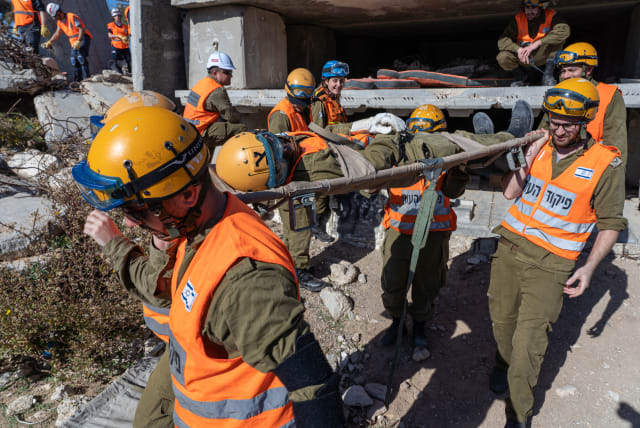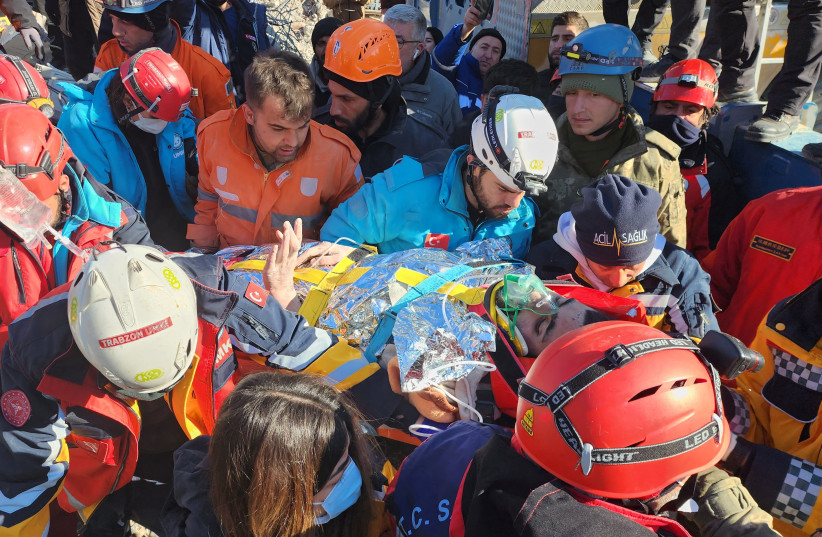Defense Ministry runs earthquake drill on receiving emergency global aid

Almost none of Israel's 80,000 buildings are capable to withstand a major quake.
Approximately a month after the earthquake in Turkey, the Defense Ministry’s National Emergency Management Authority (NEMA) on Sunday managed the start of a multi-day international exercise focused on receiving global aid in the event of an earthquake.
Together with a variety of Israeli emergency and rescue agencies and involving around 120 participants from 17 countries, the exercise is slated to run until Wednesday of this week, said the ministry.
The foreign countries and international bodies involved include: from Albania, Austria, Belgium, Bosnia, Bulgaria, the Czech Republic, Estonia, Finland, France, Germany, Latvia, Macedonia, Malta, Montenegro, Romania, Spain, Sweden, the EU and the UN.
The earthquake exercise
According to the ministry, “The exercise will simulate all necessary emergency procedures including the initial decision to request international assistance, integrating foreign rescue teams, distributing aid to various locations within the country, and the receival process of international aid.”
“Some scenarios being simulated during the exercise include earthquake search and rescue operations, evacuation drills, damage assessment processes,” and receiving international aid from various countries, said the ministry.
Director of the National Emergency Management Authority, Brig. Gen. (Res.) Yoram Laredo, said, “The National Emergency Management Authority designated 2023 as the year to focus on improving national earthquake preparedness, with the devastating earthquake in Turkey further emphasizing the challenges that we face.”
“The highly esteemed cooperation with our partners abroad is a crucial element in achieving this and enhances the State of Israel’s capacity to receive extensive humanitarian aid in emergency situations,” he added.
Despite the positive impact of the drill, on February 6, a top Israeli official familiar with earthquake management policy told the Jerusalem Post that, “it could take Israel over a decade to be ready for getting hit by an expected eventual large earthquake even if it started to do all of the right things immediately.
“It will take a long time to carry out the plan,” for improving the structural integrity of buildings across the country, “but it would take longer to rebuild after an earthquake. I don’t know how it would be handled. It could take more than 10 years,” said the senior official.
On one hand, the IDF Home Front Command, the National Emergency Authority (RAHEL), including its special earthquakes steering committee, the police and fire departments, the Construction Ministry, the Health Ministry, the Transportation Ministry, the Education Ministry and a variety of other authorities involved have made significant progress in search and rescue and electronic warning capabilities when it comes to earthquakes.
On the other hand, the official said that despite repeated warnings from the State Comptroller, at Knesset hearings and from think tanks, almost none of the around 80,000 buildings in the country which are highly vulnerable to earthquakes have received the improvements needed to help them withstand a major quake.
Essentially, the general rule is that only buildings put up after 1980 were constructed with the concept of being able to withstand earthquakes.
Previously, the government allocated NIS 5 billion to strengthen buildings to withstand earthquakes.
But by August 2020, the Construction Ministry reported to the Knesset State Control Committee that only NIS 7 million had been expended.
The official told the Post that since then the number has jumped past NIS 150 million, especially regarding certain portions of the North that are viewed as being more vulnerable.
But he said that most of the funds have still not been used.
Jerusalem Post Store
`; document.getElementById("linkPremium").innerHTML = cont; var divWithLink = document.getElementById("premium-link"); if (divWithLink !== null && divWithLink !== 'undefined') { divWithLink.style.border = "solid 1px #cb0f3e"; divWithLink.style.textAlign = "center"; divWithLink.style.marginBottom = "15px"; divWithLink.style.marginTop = "15px"; divWithLink.style.width = "100%"; divWithLink.style.backgroundColor = "#122952"; divWithLink.style.color = "#ffffff"; divWithLink.style.lineHeight = "1.5"; } } (function (v, i) { });

